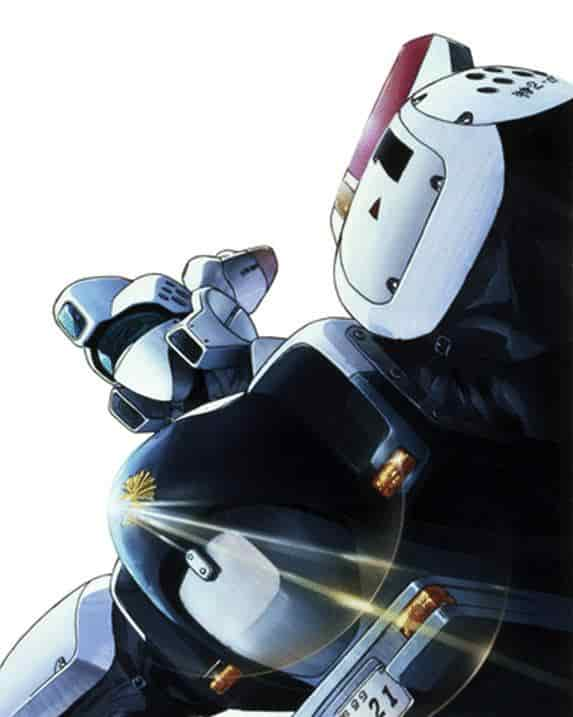The appeal and evaluation of the TV version of "Mobile Police Patlabor": A realistic world view that is still relevant today

Mobile Police Patlabor PATLABOR ON TELEVISION - Mobile Police Patlabor PATLABOR ON TELEVISION -■ Public MediaTV anime series ■ Original MediaAnime Original ■ Broadcast periodOctober 11, 1989 - September 26, 1990 ■Broadcasting stationTX ■Frequencieshalf an hour ■ Number of EpisodesEpisode 47 ■Original Story・Original work/Headgear ■ DirectorDirector: Naoyuki Yoshinaga ■ Production・Production cooperation: Sunrise ・Production: Bandai Visual, Tohokushinsha ■Works©HEADGEAR/BANDAI VISUAL/TFC ■ExplanationFollowing the positive reception of the first season of the OVA, a 47-episode TV series was produced in parallel with the first movie, "Mobile Police Patlabor the Movie," and began airing in October 1989, about three months after the movie's release. Due to the need to develop a new story for the TV series, the chronological order of the first season of the OVA and the first movie is slightly different. However, the second season of the OVA and the second movie, "Mobile Police Patlabor 2: The Movie," which were produced further, are part of the same timeline as the TV series, so they can be said to be the beginning of a new "Patlabor" series. The first software release, which also included the second season of the OVA, began in November 1990 as the P series, and a total of 16 volumes were released. "Mobile Police Patlabor" is a robot anime series produced by Sunrise from the late 1980s to the early 1990s, and the TV series in particular holds a special place in the hearts of fans. Compared to the OVA and film versions, it features many more everyday episodes and carefully portrays the relationships and growth of the characters. In particular, viewers can gain a deeper understanding of the personalities and bonds of the members of Special Vehicle Section 2 through their daily lives and work. The TV series was broadcast on Tokyo Television Network (TX) from October 11, 1989 to September 26, 1990. It was a long-running series with 47 episodes, broadcast in a 30-minute time slot every Wednesday from 22:00 to 22:30. At the time of broadcast, the aim was to attract a wider audience following the success of the original animation (OVA) and film adaptation. In fact, the TV series was supported by a wide range of people, and was especially popular with young people and anime fans. The story is set in Tokyo in the near future. In a society where labor robots called "Labors" have become widespread, the story follows the activities of Special Vehicle Section 2, which was established to prevent crimes and accidents caused by Labors. The protagonist, Akira Izumi, is a rookie pilot of Special Vehicle Section 2, and she faces various incidents with her colleagues. Her growth and the bond with her colleagues are at the center of the story, and viewers can experience the daily life of Special Vehicle Section 2 from her perspective. One of the charms of the TV series is that each episode depicts a different incident or problem. A wide variety of stories are told, ranging from rampaging Labors and terrorist attacks to everyday troubles. In particular, the early episodes show how the members of the Second Special Vehicle Unit come together as a team, allowing viewers to sense their growth. Also, from the middle of the series onwards, there are more episodes that tackle deeper themes and social issues, and the show contains a lot of content that will get viewers thinking. The characters are also very appealing. Each member of Special Vehicle Section 2, including Izumi Noa, is portrayed as a unique and attractive character. In particular, the backgrounds and relationships of each character, such as Izumi Noa's partner Shinohara Yuuma and Special Vehicle Section 2 leader Shinshi Mikiyasu, are carefully drawn, making it easy for viewers to empathize with them. Many guest characters also make appearances, adding color to each episode. The mechanical design is also an element not to be missed. The labor designs by Izubuchi Yutaka are realistic and sophisticated, and have an appeal that draws viewers in. In particular, the Ingram piloted by Izumi Noa is a symbol of the TV series, and its movements and battle scenes are worth watching. Sayama Yoshinori also participated as a guest mecha designer, and one of the things to look forward to is the appearance of different labors in each episode. The music also plays an important role. Kenji Kawai's music is effective in enhancing the excitement of the tense battle scenes and moving scenes. The opening theme "Patlabor of the Lonely" and the ending theme "Letter to Tomorrow" are masterpieces that are deeply engraved in the hearts of viewers, further enhancing the atmosphere of the series. The success of the TV series had a major impact on the subsequent development of the Patlabor series. The second season of the OVA and the second movie, Mobile Police Patlabor 2: The Movie, are positioned in the chronological order of the TV series, and fans of the TV series can enjoy them as sequels. In addition, the success of the TV series led to various media mix developments, and games, novels, manga, and more were produced. These works further expanded the worldview of the TV series and continue to be loved by fans. The TV series has been highly praised, especially for its appealing characters, story development, mechanical design, and music. It also has many episodes that deal with social issues and human relationships, and is praised for including content that makes viewers think. Another appealing aspect of the TV series is that it has more episodes that are more mundane than the OVAs and film versions, allowing viewers to get up close and personal with the characters' lives and work. "Mobile Police Patlabor: PATLABOR ON TELEVISION" holds a special place in the hearts of anime fans from the late 1980s to early 1990s, and it has had a major impact on the development of the "Patlabor" series since then. Viewers can experience the excitement and emotion of watching the members of Special Vehicle Section 2 grow and develop, bond with each other, and face various incidents and problems. This TV series is still loved by many fans today, and its appeal will never fade. ■Cast・Noa Izumi/Miina Tominaga/Yuma Shinohara/Toshio Furukawa/Mikiyasu Shinji/Kazunari Futamata/Isao Ota/Michihiro Ikemizu/Hiromi Yamazaki/Daisuke Gori/Clancy Kanuki/Yo Inoue/Shigeo Shiba/Shigeru Chiba/Seitaro Sakaki/Osamu Saka/Kiichi Goto/Ryusuke Obayashi/Shinobu Nagumo/Yoshiko Sakakibara ■ Main staff Original story/Headgear/Character design/Masami Yuuki (serialized in Shogakukan's Weekly Shonen Sunday) ■Subtitle Episode 1: Ingram Activation (1989/10/11) |
<<: Jungle Emperor 1989 Review: A Deeper Look at Episodes 3 and 4 of the TV Series
>>: A thorough review of the first season of Fujiko Fujio A's "The Laughing Salesman"!
Recommend
Unravelling the confusion surrounding Under the Dog: Review and analysis
"Under the Dog Jumble": The appeal of c...
Makoto Shinkai's next masterpiece "Weathering with You" theme song MV released
Today (October 24), the animated film "Weath...
Weiwei's cherry-colored youth dream! The latest One Piece collaboration CM with Japan
On September 17, 2019, we reported on the "O...
Venom director: Sony is preparing for a collaboration between Venom and the Dutch version of Spider-Man
"Venom: Let There Be Carnage" has achie...
The appeal and evaluation of "Misaki Chronicle" Divergence Eve
"Misaki Chronicle: Divergence Eve": A m...
The Truth About Tamagotchi: A Touching Story and Its Evaluation
Tamagotchi: The Real Story - Nostalgic characters...
The appeal and reviews of "The Seed of Water": A thorough explanation of the moving story and beautiful visuals
"Water Seed" - The appeal and backgroun...
The new Chinese version of the movie "Black Widow" will be released in North America on July 9
The official Weibo account of Marvel Studios rele...
Marvel's new drama "Hawkeye" released a preview trailer and will be broadcast on November 24
Marvel Studios’ new drama “Hawkeye” released a te...
Successful in career and love, "Three Idiots" got married in a low-key manner in Las Vegas, USA
Sophie Turner, the "three idiots" in &q...
The appeal and reviews of "Rokumon Tengai Moncolle Night": An anime experience not to be missed
"Rokumon Tengai Moncolle Night" - A TV ...
Grandpa's Fireworks: A fusion of moving story and beautiful images
"Grandpa's Fireworks" - A heartwarm...
The appeal and evaluation of "Tokyo Mew Mew": A masterpiece of girls' anime seen from a modern perspective
"Tokyo Mew Mew": A magical story of gir...
Beijing Universal Studios Theme Park releases latest promotional video and will open in spring 2021
The world-famous film and television amusement pa...
The appeal and evaluation of High School DxD BorN: A fusion of action and fantasy
High School DxD BorN - A fascinating world of fan...









